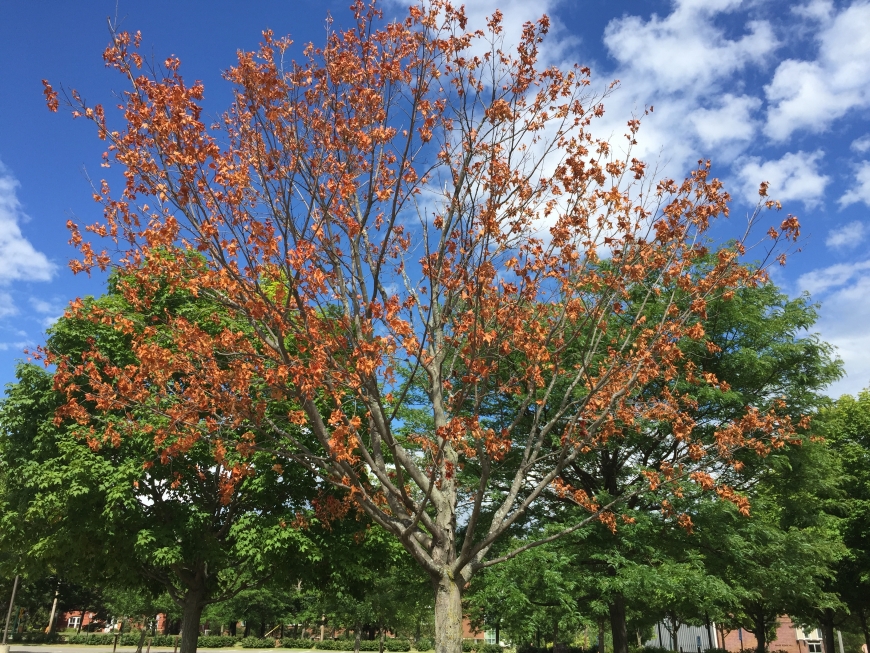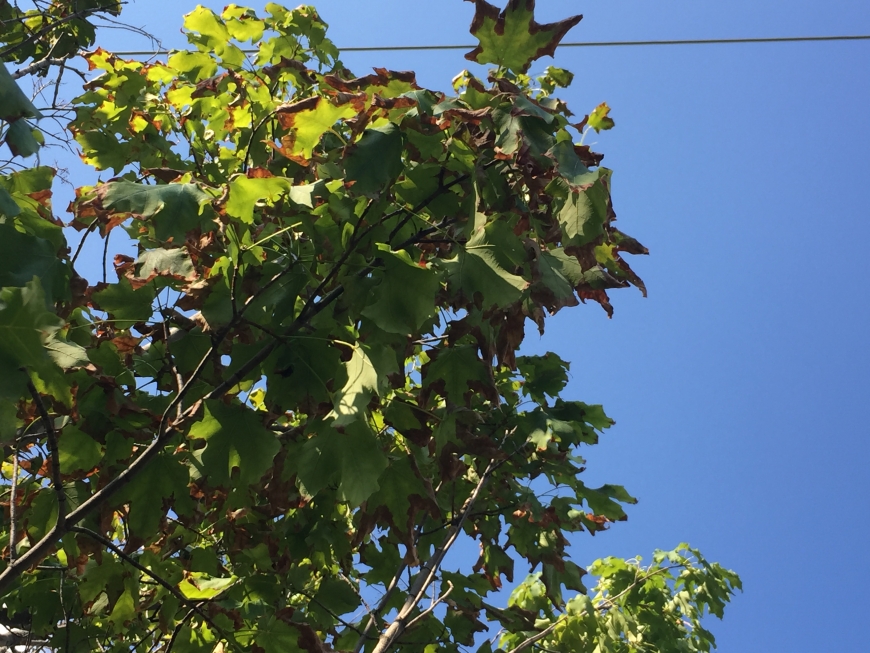

This sugar maple in Canton has not fared well in the summer drought.
Curling leaves and early color change are signs of drought stress in trees.


The Drought of 2016
They say that every cloud has a silver lining, but what happens when all you really need is a cloud? The Drought of 2016 (sounds more ominous when I capitalize it like that) has really beat up on gardens and landscapes. You know it’s dry when dandelions begin to shrivel up, which is the case in my yard. The problems wrought by the drought are (mostly) obvious, but is there a silver lining anywhere?
Turns out that 2016 has been a very good year for healthy garden plants. Let’s talk about the dreaded late blight (notice I resisted the impulse to use caps), scourge of tomatoes and potatoes the world over. Unlike many garden diseases, late blight spores do not reside in the soil; they blow north from southern states over the course of the growing season. For late blight, UV radiation is worse than Kryptonite—just 45 minutes of sunshine and they are toast. So far, the risk of late blight has been about as low as it can get.
Even plant diseases that reside in soil have had a lousy season. Early blight, which is unrelated to late blight despite having a last name in common, is the pathogen that kills your tomato plant starting from the bottom, and progresses upward over the summer. It infects the lowest leaves when water splashes spore-laden soil onto them. These infected leaves soon begin to release spores, which the rain splashes onto their neighbors above, and so on. Septoria spot is another garden-variety pathogen that employs the same strategy. In a wet year, these soil-borne pathogens can severely damage one’s tomato crop.
Powdery mildew and downy mildew, two diseases of cucumbers and squash, are airborne agents, so it is hard to avoid them when their spores reach us from down south. However, they need wet leaves to get started, so the weather is again in our favor where these pathogens are concerned.
But dry soil can actually cause a “disease” on tomatoes. Blossom-end rot turns the bottom of the tomato black, looking for all the world like some fearsome fungus has attacked. This is a symptom of calcium deficiency—not in the soil, though; just in the tomato. When plants lack water, they are unable to get enough calcium from the soil to fully form the tomatoes. You can spray to cure blossom-end rot. The product? Water.
Mulching heavily with some type of organic matter is a gardener’s best defense against drought, and a lot of other things besides. Because mulch conserves moisture, it will help prevent blossom end rot. Laying mulch at the same time you set out tomato transplants will prevent soil from splashing onto leaves and initiating the disease cycle. Obviously mulch also helps keep weeds at bay, and it is a form of slow-release fertilizer as well.
If your lawn turns brown, don’t panic. Turf grasses are programmed to become dormant when they run out of water. Their root crowns are alive and well, just sleeping. As much as possible, keep off dry lawns, as root crowns are much more prone to physical damage when dormant. If it’s any consolation, dry grass is impervious to diseases. When we get enough rain, lawns will perk up once again.
That is not the case for trees, however, which have no mechanism to sit out dry periods. Their fine absorbing roots begin to die back, and when it finally does rain they will have to replace those structures before they can even get a drink. The drought of 2016 will have negative impacts on trees for perhaps as many as five years.
The take-home message? Mulch the garden for happier plants; let your grass sleep, but water your trees, and pray for clouds, regardless of whether they have silver linings.

